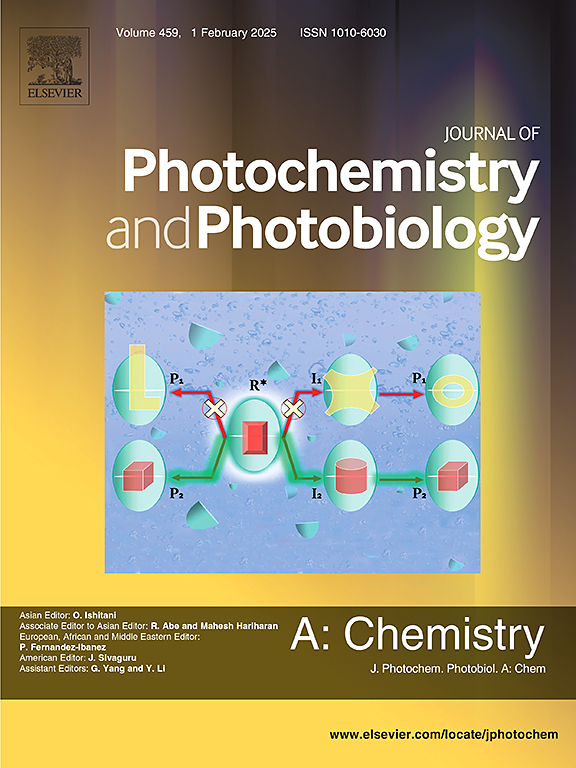A photosensitive tricarbonyl Mn(I) CO-releasing molecule of 6-mercaptopurine: Genotoxicity and mode of cell death
IF 4.1
3区 化学
Q2 CHEMISTRY, PHYSICAL
Journal of Photochemistry and Photobiology A-chemistry
Pub Date : 2025-07-03
DOI:10.1016/j.jphotochem.2025.116587
引用次数: 0
Abstract
Two photosensitive tricarbonyl manganese(I) complexes [MnX(bpy)(CO)3]0/+ (X = Br (1) and 6-mercaptopurine (2); bpy = 2,2′-bipyridine) were tested for their antiproliferative effects against six normal and malignant cell lines of various origins under dark and 468 nm light exposure. 6-Mercaptopurine is a widely recognised therapeutic drug used to treat human leukaemia. Compound 1 was highly toxic to the THP-1 cell line, with an IC50 value of 13.6 ± 1.2 μM in light and 3.0 ± 0.1 μM in dark, while 2 had no effect on it. On the other hand, 2 demonstrated slighlty toxicity towards HepG2 cells, with IC50 values of about 100 μM under dark and light conditions. The illumination at 468 nm increased the formation of the reactive oxygen species (ROS) of both 1 and 2 in comparison to the dark ones. Complex 1 had the greater capacity for apoptosis, which was the predominant mode of cell death. The Comet assay confirmed the genotoxicity of both complexes and the light conditions caused significant genotoxic damage compared to the dark conditions.

6-巯基嘌呤光敏三羰基Mn(I) co释放分子:遗传毒性和细胞死亡方式
两种光敏三羰基锰(I)配合物[MnX(bpy)(CO)3]0/+ (X = Br(1)和6-巯基嘌呤(2);Bpy = 2,2 ' -联吡啶)在黑暗和468 nm光照射下对6种不同来源的正常和恶性细胞系进行了抗增殖作用试验。6-巯基嘌呤是一种广泛认可的用于治疗人类白血病的治疗药物。化合物1对THP-1细胞株具有较强的毒性,光照下IC50值为13.6±1.2 μM,黑暗下IC50值为3.0±0.1 μM,而化合物2对THP-1细胞株无影响。另一方面,2对HepG2细胞表现出轻微毒性,在黑暗和光照条件下的IC50值约为100 μM。与暗光相比,468 nm的光照增加了1和2的活性氧(ROS)的形成。复合体1具有更大的凋亡能力,这是细胞死亡的主要方式。彗星试验证实了这两种复合物的遗传毒性,与黑暗条件相比,光照条件造成了显著的遗传毒性损害。
本文章由计算机程序翻译,如有差异,请以英文原文为准。
求助全文
约1分钟内获得全文
求助全文
来源期刊
CiteScore
7.90
自引率
7.00%
发文量
580
审稿时长
48 days
期刊介绍:
JPPA publishes the results of fundamental studies on all aspects of chemical phenomena induced by interactions between light and molecules/matter of all kinds.
All systems capable of being described at the molecular or integrated multimolecular level are appropriate for the journal. This includes all molecular chemical species as well as biomolecular, supramolecular, polymer and other macromolecular systems, as well as solid state photochemistry. In addition, the journal publishes studies of semiconductor and other photoactive organic and inorganic materials, photocatalysis (organic, inorganic, supramolecular and superconductor).
The scope includes condensed and gas phase photochemistry, as well as synchrotron radiation chemistry. A broad range of processes and techniques in photochemistry are covered such as light induced energy, electron and proton transfer; nonlinear photochemical behavior; mechanistic investigation of photochemical reactions and identification of the products of photochemical reactions; quantum yield determinations and measurements of rate constants for primary and secondary photochemical processes; steady-state and time-resolved emission, ultrafast spectroscopic methods, single molecule spectroscopy, time resolved X-ray diffraction, luminescence microscopy, and scattering spectroscopy applied to photochemistry. Papers in emerging and applied areas such as luminescent sensors, electroluminescence, solar energy conversion, atmospheric photochemistry, environmental remediation, and related photocatalytic chemistry are also welcome.

 求助内容:
求助内容: 应助结果提醒方式:
应助结果提醒方式:


